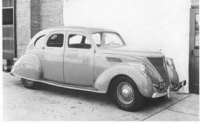Lincoln Zephyr
The Lincoln Zephyr, designed by John Tjaarda and Howard Bonbright of the Briggs Manufacturing Company for Ford under the supervision of Henry's son, Edsel, and revised by Bob Gregorie (see below), was introduced in 1936. It was based on an earlier rear-engine design by Tjaarda, the Briggs Dream Car shown at The Century of Progress Exhibition in 1933-1934. (See separate article on this car) The design had a short front hood which sloped down quickly (similar to the original VW Beetle) which was consistent with the new "streamlining" trend. Gregorie had just been chosen in 1935 by Edsel Ford to head up Ford's new internal styling group, which from this time on would not need to use Briggs or any other outside styling sources. Gregorie used his new authority well. He had witnessed the 1934 controversial introduction of the Chrysler Airflow (see separate article on this car) which was "too streamlined" to suit public taste. In particular, the public disliked the blunt, rounded hood. He did not repeat this fatal error. So he moved the engine (of the Dream Car concept) to the front and added a graceful hood shape similar to an inverted, underwater ship's prow, which dramatically changed the character of the design. Gregorie's classic revised design was patented in 1935. The name Zephyr was clearly a reference to the first truly streamlined train, the Burlington Silver Streak Zephyr, designed by Albert Dean of the Budd company, that debuted at the Century of Progress Exhibition in Chicago in 1934. The very word, Zephyr, suggested the latest in streamlining technology. The Museum of Modern Art later called the Lincoln Zephyr the first successful streamlined car in the US, and it led to the even more classic Lincoln Continental of 1939. Eugene Turrenne "Bob" Gregorie, Jr., US auto designer was born in New York City in 1908. In 1927 he started as a draftsman at Elco Boat Works in Bayonne, NJ, and moved to yacht designers Cox & Stevens in NY in 1928. In 1929 he began automotive work at Brewster & Company, and the same year at General Motors with Harley Earl, but almost immediately the stock market crash cost him his job, and he returned to Cox and Stevens. In 1931 Gregorie took a position at the Lincoln Motor Company off and on as a body draftsman. He gained in experience and in the admiration of Edsel Ford and in 1935 was placed in charge of the new styling group at Ford. He also designed the first Mercury and the Lincoln Continental in 1939. With the death of Edsel Ford in 1943, Gregorie briefly left the company but returned in 1944 at the request of Henry Ford II. In 1946, he set sail for 15 years on the trawler he designed, The Drifter. In the mid-1970s he retired to St. Augustine, FL.
